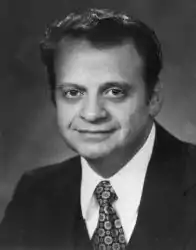Vincent Barabba
Vincent Barabba (born September 6, 1934) is an American market researcher, author, former head of the United States Census Bureau, and the chairman and co-founder of Market Insight Corporation. He is known for his work in the field of market research and opinion polling.
Vincent Barabba | |
|---|---|
 | |
| 14th Director of the United States Census Bureau | |
| In office 1973–1976 | |
| President | Richard Nixon Gerald Ford |
| Preceded by | George Hay Brown |
| Succeeded by | Manuel D. Plotkin |
| In office 1979–1981 (Acting) | |
| President | Jimmy Carter |
| Preceded by | Manuel D. Plotkin |
| Succeeded by | Bruce Chapman |
| Personal details | |
| Born | September 6, 1934 Chicago, Illinois |
| Education | California State University, Northridge University of California, Los Angeles |
Biography
Born in Chicago, Illinois, Barabba was awarded a bachelor's degree in marketing in 1962 from California State University, Northridge and, in 1964, an M.B.A. in marketing from the University of California, Los Angeles.[1] He was also awarded an Honorary Doctor of Laws in 2012 by California State University, Northridge.[2]
Beginning as political campaign survey researcher in the 1964 California Republican primary between Nelson Rockefeller and Barry Goldwater, Barabba moved on to become a business market researcher (eventually Director of Market Intelligence) for Xerox Corp. and Eastman Kodak. He co-founded and was chairman of Market Insight Corporation,[3] Until 2003 he was General Manager of Corporate Strategy and Knowledge Development at General Motors, where he conceived and devised OnStar and MyProductAdvisor.
He is a Past President of the American Statistical Association, and served twice as head of the US Census Bureau (the only to be appointed by a President of a different political party)[2][4] and currently serves as a Commissioner of the California Citizens Redistricting Commission.[5] He is chairman of The State of the USA, a nonprofit corporation providing quality information to the American public on societal, economic, and environmental conditions.
Awards
In recognition of his private and public sector performance, Barabba was awarded:
- Fellow of the American Statistical Association, 1976[6]
- Induction into the Market Research Council's Hall of Fame [7]
- The American Marketing Association’s Parlin Award for leadership (1996) in the application of science to marketing research [8]
- The MIT/General Motors Buck Weaver Award for individuals who have contributed significantly to the advancement of theory and practice in marketing science [9]
- The System Dynamics Society’s Applications Award for the best “real world” application of system dynamics [10]
- The American Marketing Association’s Explor Award granted to organizations that have demonstrated the most innovative uses of technology in applications that advance research [11]
- The Certificate of Distinguished Service for Contribution to the Federal Statistical System from the US Office of Management and Budget
Publications
Barabba has authored or co-authored numerous books and articles, including:
- 1968 “Political Campaign Management: Myth and Reality” The Ethics of Controversy: Politics and Protest. Proceedings of the First Annual Symposium on Issues in Public Communication, held at the University of Kansas June 27–28
- 1983 (With Mason, R.O. and Mitroff, I.I.) “Federal Statistics in a Complex Environment: The Case of the 1980 Federal Census,” The American Statistician, Volume 37, No. 3, Washington, DC: The American Statistical Association
- 1985 “Steel Axes for Stone Age Men” in: Buzzell, R., Marketing in an Electronic Age, 75th Anniversary Harvard Business School Research Colloquium, Boston: Harvard Business School Press
- 1991 (With Zaltman, G.) Hearing the Voice of the Market: Competitive Advantage through Creative Use of Market Information, Boston: Harvard Business School Press
- 1994 “Never Say the Model Says. The Role of Models in Managerial Decision Making” in Wallace, W. Ethics in Modeling, New York: Pergamon Press
- 1998 “Revisiting Plato’s Cave: Business Design in an Age of Uncertainty,” in Tapscott, D. et al., eds., Blue Print for the Digital Economy, New York: McGraw-Hill
- 2002 (With Huber, C., Cooke, F., Pudar, N., Smith, J., and Paich, M.) “A Multi-Method Approach for Creating New Business Models: The General Motors OnStar Project”, Interfaces, 32 (1), pp. 20–34
- 2002 (With Pourdehnad J. and Ackoff, R.) “Above and Beyond Knowledge Management” in Chun, W. C. and Bontis, N. (eds) The Strategic Management of Intellectual Capital and Organization Knowledge, Oxford: Oxford University Press, pp. 359–369
- 2004, Surviving Transformation, New York: Oxford University Press. pp. 170–171
- 2011, The Decision Loom: a design for interactive decision-making in organizations
References
- ACASA UPENN "http://www.acasa.upenn.edu/barabba.htm"
- https://www2.calstate.edu/impact-of-the-csu/alumni/Honorary-Degrees/Pages/vincent-p-barabba.aspx
- Market Insight Corp. "http://www.marketinsightcorp.com/about-us.html"
- Census Bureau "https://www.census.gov/history/www/census_then_now/director_biographies/directors_1965_-_1976.html#barabba"
- CCRC "http://wedrawthelines.ca.gov/bios.html"
- View/Search Fellows of the ASA, accessed 2016-08-20.
- Hall of Fame "http://www.mrcouncil.org/hall.htm"
- Parlin recipients "http://themarketingfoundation.org/parlin_recipients.html"
- MIT/GM Award "http://www.stateoftheusa.org/about/staff-and-leadership/#Barabba"
- Systems Dynamics Society Award "http://www.systemdynamics.org/AwardRecipients.htm#SDApplicationsAwards"
- Explor Award "http://www.marketinsightcorp.com/endorsement/explor"